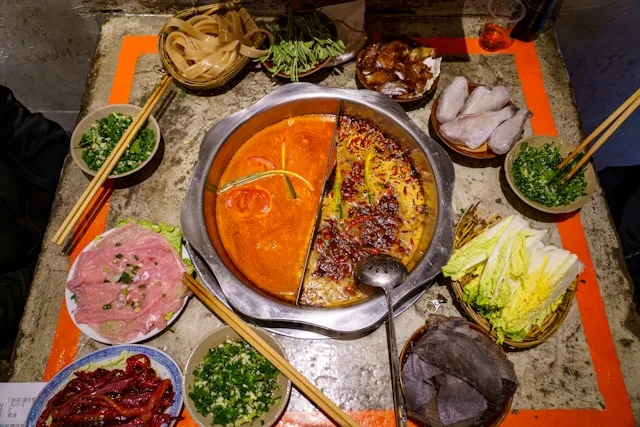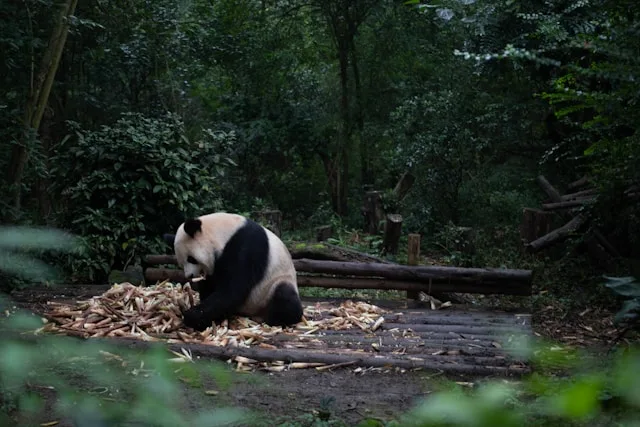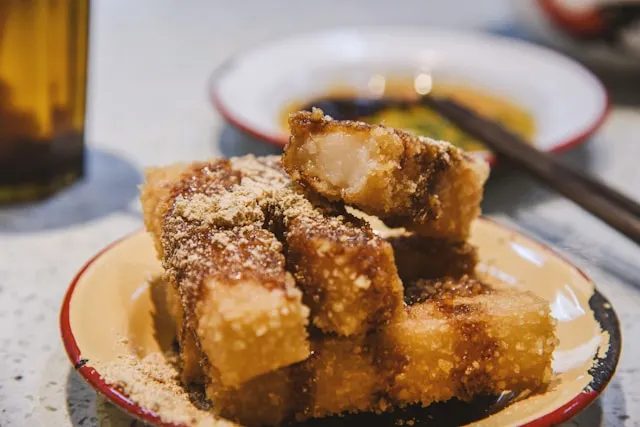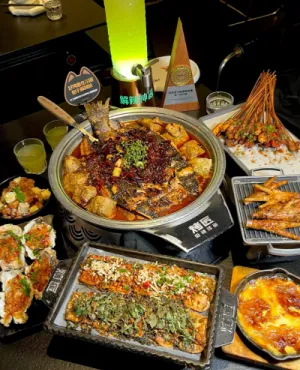Top 26 Chengdu Foods You Must Try – A Local’s Ultimate Guide

Hello friends, Lukas here!
Picking the first blog post? Total brain-melter. Do I ramble about the Great Wall’s windy hikes? Nah, too touristy. Pandas? Cute, but we’ve got deeper cravings. Finally, I decided we have to start with the food in Chengdu! After all, this is our home, and it’s the place we know and love the best.
Chengdu – “Land of Abundance” (天府之国, Tiānfǔ zhī Guó)
Chengdu, the capital of Sichuan, has been called the “Land of Abundance” (天府之国 – Tiānfǔ zhī guó) since ancient times. There’s even an old saying: “Don’t enter Sichuan when you are young” (少不入川 – shào bù rù chuān), because the comfortable, vibrant life here might make you lose your ambition!

The food culture in Chengdu is especially amazing. It’s different from the food in Chongqing, which is famous for a very direct, strong, and straightforward spiciness. I think Chengdu’s food can be summarized in two characters: 融合 (rónghé).
Rónghé means fusion, blending, and integration. It’s the genius of mixing all kinds of spices and ingredients to create complex, multi-layered flavor profiles. For example, the famous “Fish-Fragrant” flavor (鱼香味 – yúxiāng wèi) doesn’t have any fish! It’s a perfect fusion of pickled chili, green onion, ginger, garlic, sugar, and vinegar. Then there’s “Strange Flavor” (怪味 – guàiwèi), which combines numbing, spicy, sweet, sour, savory, and fragrant tastes all in one bite.
This idea of rónghé is a perfect match for the spirit of Chengdu itself—a city that is open, tolerant, and welcoming to all.
Haha, okay, I talked a little too much. Let’s get back to the main topic. Here are the 26 dishes you absolutely must eat when you come to Chengdu!
Breakfast: A Perfect Start with Chengdu Noodles
In Chengdu, we don’t do cold cereal. We wake up our stomachs with something hot, savory, and often a little spicy. It’s cheap (under 12 RMB), communal, and hits that “I’m alive” spot.
- Beef or Pork Rib Noodles (牛肉/排骨面 – Niúròu/Páigǔ Miàn)
This is the ultimate comfort breakfast. Imagine a big bowl of chewy noodles swimming in a rich, deeply savory, and slightly spicy red broth that has been simmering for hours. It’s topped with chunks of beef or pork ribs so tender they fall off the bone. It’s a warm hug in a bowl. Hardy swears by it post-gym (lies—he’s just lazy like me). Fuel for temple-hopping. - Dan Dan Noodles (担担面 – Dàndàn Miàn)
Perhaps the most famous Sichuan noodle! The name comes from the shoulder poles (dàndàn) that street vendors used to carry their stoves and ingredients. These aren’t soup noodles; they are served “dry” with a small amount of intensely flavorful sauce at the bottom. You mix it all up to coat the noodles in chili oil, savory minced pork, preserved vegetables, and numbing Sichuan peppercorns. - Sweet Water Noodles (甜水面 – Tiánshuǐ Miàn)
This one is very special to Chengdu. The noodles themselves are the star—they are incredibly thick, square-shaped, and super chewy. The sauce is a delicious contradiction, a mix of sweet brown sugar, soy sauce, garlic, and a serious kick of chili oil. It sounds strange, but the combination is addictive. - Intestine Noodles (肥肠粉 – Féicháng Fěn)
Okay, for our more adventurous friends! This is a local obsession. The noodles are slippery, transparent sweet potato noodles, and they are served in a rich, cloudy, and deeply flavorful broth made from simmering pork intestines. It’s served with chunks of the intestine itself. If you’re brave, the reward is an incredibly delicious and unique taste.
Midday Exploration: The Best Sichuan Street Food
Chengdu’s streets are snack central—smoky carts, haggling aunties, and zero regrets. As you walk around Chengdu, you’ll be tempted by snacks at every corner. Don’t resist!
- Longchaoshou (龙抄手 – Lóng Chāoshǒu)
These are Chengdu’s version of wontons. The name literally means “Dragon-Copied Dumplings.” The dumpling skin is silky and thin, wrapped around a fresh, savory pork filling. You can get them in a clear soup, but the real Chengdu way is “red oil” style (红油抄手 – hóngyóu chāoshǒu), tossed in a fragrant, spicy chili oil sauce. - Zhong Dumplings (钟水饺 – Zhōng Shuǐjiǎo)
Different from other dumplings, these are filled only with pork, no vegetables. The magic is in the sauce. It’s a special sweetened soy sauce, thick and aromatic, mixed with mashed garlic and chili oil. It’s more savory and fragrant than purely spicy, and the combination is just perfect. - Chuan Chuan Xiang (串串香 – Chuànchuàn Xiāng)
This is like a mini, mobile hot pot! The name means “fragrant skewers.” You go to a shop with a huge refrigerator full of hundreds of different ingredients on bamboo skewers—vegetables, meats, tofu, everything! You grab a big bucket, pick whatever you want, and they cook it for you in a hot, spicy broth. It’s fun, casual, and delicious. - Tangyou Guozi (糖油果子 – Tángyóu Guǒzi)
Time for something sweet! These are little balls of glutinous rice, deep-fried until they are puffy and hollow. They are then coated in a bubbling syrup of brown sugar and sprinkled with sesame seeds. The result is a perfect snack that’s crispy and sweet on the outside, and soft and chewy on the inside. - Langya Potatoes (狼牙土豆 – Lángyá Tǔdòu)
The name means “Wolf-Tooth Potatoes” because they are cut with a special crinkle-cutter. These thick potato batons are fried until they are just right—not too crispy, not too soft—and then tossed in a bowl with a mix of chili powder, Sichuan peppercorns, cumin, green onions, and cilantro. It’s the ultimate savory street snack.
Lunch: The 6 Famous Sichuan Dishes of Chengdu
When you sit down for a proper meal, these are the classic dishes you will see on every menu. They are the soul of Sichuan cuisine: bold, balanced, begging for rice.
- Mapo Tofu (麻婆豆腐 – Mápó Dòufu)
The legendary dish invented by a grandmother (pópo) with a pockmarked face (mázi). Don’t be fooled by the simple ingredients. It’s a universe of flavor: the numbing sensation (má) of Sichuan peppercorns, the spicy heat (là) of chili, the rich taste of fermented bean paste, and the savory minced beef all come together with silky soft tofu. - Kung Pao Chicken (宫保鸡丁 – Gōngbǎo Jīdīng)
Famous all over the world, but the real version here is so much better. The flavor profile is called húlà lìzhī wèi (糊辣荔枝味), or “paste-chili and lychee flavor.” It’s a brilliant balance of spicy from the chilies, sour from vinegar, and sweet from sugar, with tender chicken and crunchy peanuts. Hardy always fights me for the last piece - Twice-Cooked Pork (回锅肉 – Huíguō Ròu)
Many chefs say if you can only cook one Sichuan dish, this is the one. It’s called “twice-cooked” because the pork belly is first boiled, then sliced thin and stir-fried in a hot wok with fermented bean paste and leeks. The pork becomes incredibly flavorful and tender, not greasy at all. - Fuqi Feipian (夫妻肺片 – Fūqī Fèipiàn)
The “King of Cold Appetizers.” The name means “Husband and Wife Lung Slices,” but nowadays it’s usually made with beef slices, tripe, and tongue. The meat is braised, thinly sliced, and then drenched in a spectacular sauce of chili oil, Sichuan peppercorn, and spices, topped with peanuts and cilantro. - Fish-Fragrant Pork Slivers (鱼香肉丝 – Yúxiāng Ròusī)
As I mentioned, there’s no fish here! This dish perfectly shows the genius of Sichuan flavor combinations. Tender pork slivers are stir-fried with wood-ear mushrooms and bamboo shoots in the magical “fish-fragrant” sauce. It’s a little sweet, sour, savory, and spicy all at once. A masterpiece. - Water-Boiled Fish/Beef (水煮鱼/水煮牛肉 – Shuǐzhǔ Yú/Niúròu)
This dish is a true feast for the eyes and the mouth. Don’t be scared by the name “water-boiled.” Tender slices of fish or beef are poached in a spicy broth, then placed in a giant bowl and completely covered with a mountain of dried chilies and Sichuan peppercorns. Finally, the chef pours sizzling hot oil over the top, making everything crackle and releasing an incredible aroma.
Dinner’s Fiery Heart – Hot Pot in Chengdu (火锅 – Huǒguō)
I had to give hot pot its own category because, in Chengdu, it’s not just a meal—it’s the main event of our social life. It’s how we celebrate, catch up with friends, and warm up on a cool night.

- Sichuan Hot Pot (四川火锅 – Sìchuān Huǒguō)
A giant pot of bubbling, fiery red broth, filled with dozens of spices, sits in the middle of the table. You order plates of raw ingredients and cook them yourself. In Chengdu, offal is very popular. You have to be brave and try things like beef tripe (毛肚 – máodù), duck intestines (鸭肠 – yācháng), and—my personal favorite for the brave—pork brain (脑花 – nǎohuā), which becomes creamy and delicious. Of course, there are also “safer” options like thinly sliced lamb, mushrooms, tofu, and potatoes. Anything can be cooked in hot pot!
Popular Hot Pot Food
鸭血 (Yā xuè, Duck Blood)
Silky cubes absorbing broth—mild, mineral depth. Vegetarian? Skip; carnivores, it’s pot gold.
黄喉 (Huáng hóu, Yellow Throat – Pig Throat)
Chewy rings, spicy-marinated. Bold chew; rewards with flavor burst.
豆芽 (Dòu yá, Bean Sprouts)
Crisp greens taming heat—fresh crunch amid chaos. Essential balancer.
午餐肉 (Wǔ cān ròu, Lunch Meat)
Spam-like slices, fried crisp—fusion fun in pot. Guilty pleasure; kids love it.
Sweets and Snacks: Cooling Down the Fire
After all that spice, you need something to cool your mouth down.
- Bingfen (冰粉 – Bīngfěn)
This is the perfect dessert after a spicy hot pot. It’s a clear, cool, and refreshing jelly made from a special plant seed. It doesn’t have much flavor on its own, so it’s served with toppings like brown sugar syrup, peanuts, raisins, and fermented rice. - Douhua (豆花 – Dòuhuā)
This is a silken tofu pudding. In other parts of China, it’s usually sweet. But in Sichuan, we have all kinds! You can get a sweet version with syrup, but the more common local style is savory and spicy, served with soy sauce, chili oil, and pickled vegetables. - Chinese Pastries (中式糕点 – Zhōngshì Gāodiǎn)
Chengdu has many traditional pastry shops selling beautiful and delicate treats. They are often less sweet than Western desserts and filled with things like red bean paste, black sesame, or nuts. They are perfect with a cup of green tea in the afternoon.

- Hongtang Ciba (红糖糍粑 – Hóngtáng Cíbā)
A beloved snack or dessert. These are blocks or patties of glutinous rice that are deep-fried until the outside is golden and crispy, while the inside remains soft and chewy. They are then drizzled with delicious brown sugar syrup and sometimes sprinkled with soybean powder.
Advanced Level: For the Truly Adventurous Foodie
Wanna level up? Tackle these bold ones— not for first-timers, but locals’ guilty thrills.
- Foil-Roasted Duck (冒烤鸭 – Mào Kǎoyā)
This is a Chengdu invention. A whole roasted duck, crispy and delicious, is chopped into pieces. But instead of being served right away, it’s then quickly blanched (“mào”) in a spicy hot pot broth along with some vegetables. It soaks up all the spicy flavor. It’s the best of both worlds! - Rabbit Head (兔头 – Tùtóu)
You will see people eating these everywhere in Chengdu. Don’t be shy! The rabbit heads are braised for hours in a broth with over a dozen spices until they are incredibly flavorful. You put on plastic gloves and dig in. The meat is tender and delicious. - Frog and Fish Head (美蛙鱼头 – Měiwā Yútóu)
This is a very popular dish for dinner. It’s like a hot pot, but the main ingredients are giant, meaty bullfrogs and a big fish head, all cooked in a spicy broth. The frog meat is as tender as chicken, and the fish head is full of soft, gelatinous meat. - Lao Ma Tihua (老妈蹄花 – Lǎomā Tíhuā)
“Old Mother’s Pig’s Trotter Soup.” This is the ultimate late-night comfort food. A pig’s trotter is slow-cooked for hours with white beans until the soup is milky white and the trotter is so soft it melts in your mouth. It’s served with a spicy dipping sauce on the side. - Boboji (钵钵鸡 – Bōbō Jī)
This looks like Chuan Chuan, but it’s completely different. All the skewered ingredients (chicken, vegetables, tofu) are cooked beforehand and then left to soak for hours in a giant earthenware pot (“bō”) filled with a fragrant chili oil sauce. It’s served cold and is perfect for a hot day. - Roasted Fish (烤鱼 – Kǎoyú)
This is another popular dinner feast. A whole fish is grilled until it’s crispy, then placed in a long metal tray and drenched in a spicy, savory broth. You can add all kinds of vegetables and tofu to cook in the broth around the fish. It’s a fun, interactive meal to share with friends.
Conclusion: More Than Just a List
Wow, that’s 26 dishes! And to be honest, this is just scratching the surface. In Chengdu, food is not just something you eat. It is a way of life, a reason to gather, and our biggest passion. So, what’s stopping you? Jet over, hit Jinli Street, and let the ma-la magic happen. Got a fave we missed? Or survived rabbit head? Drop a comment—we’re listening (and hungry).
For our next blog post, we are planning to share our personal list of the 10 best restaurants in Chengdu where you can find many of these amazing foods. Stay tuned!
Happy eating!
